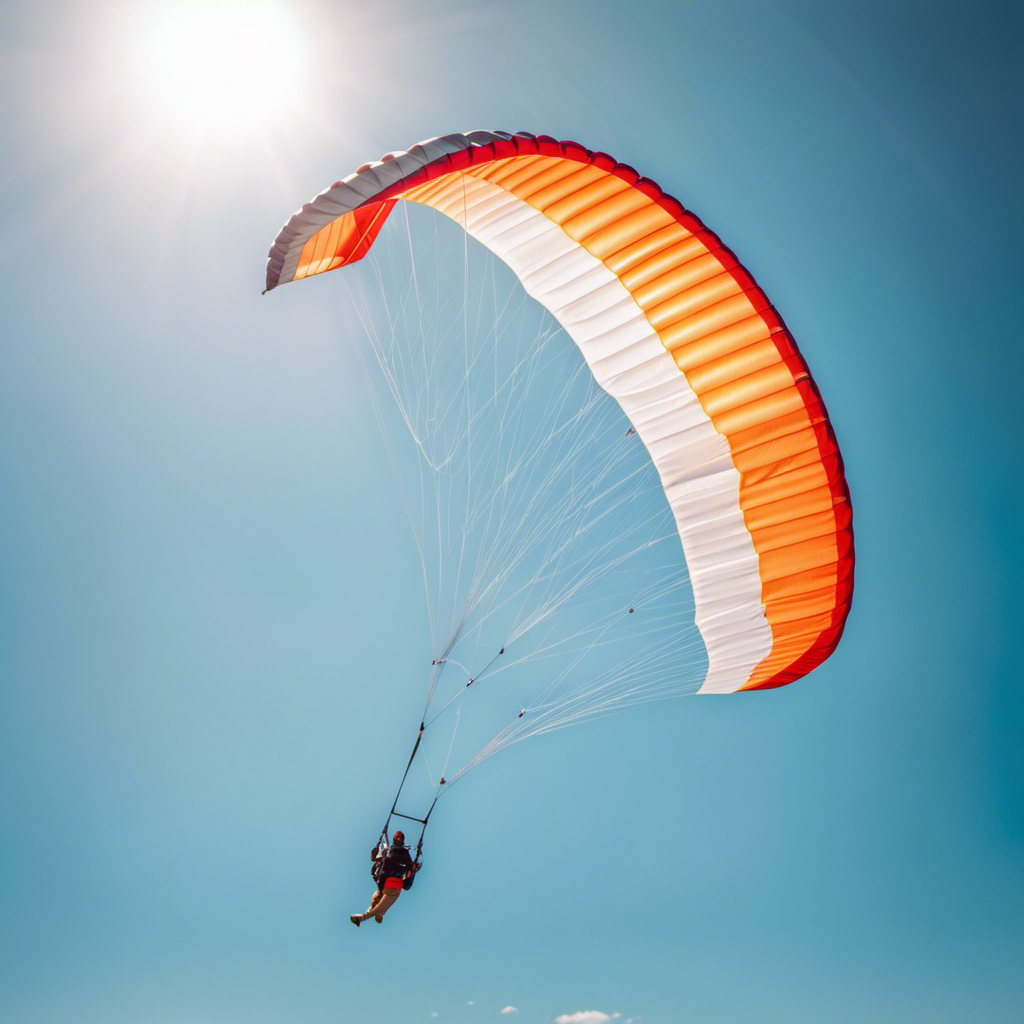Flying through the sky is an exhilarating experience that has truly lifted me to new heights. It’s not just about the takeoff; it’s also about defying gravity and enjoying the limitless freedom above.
In this article, I’ll take you on a journey through the history of soaring, the basics of gliding, and the different types of gliders you can try.
I’ll also share tips on finding a soaring club or school, the equipment and gear you’ll need, and the thrill of competing in soaring events.
Get ready to soar like never before!
Key Takeaways
- Soaring is a hobby that has a rich history, with advancements in materials, aerodynamics, and instrumentation leading to modern gliders equipped with advanced navigation systems and lightweight construction materials.
- Gliders rely on lift to stay airborne, balancing the weight of the glider with the lift generated by the wings, and minimizing drag for better performance. Gaining altitude is achieved by riding on thermals.
- Getting started in soaring involves finding a reputable soaring club or school with experienced instructors and a strong safety record, considering the training program that fits your schedule, budget, and goals, and using online directories and local organizations for more information and networking opportunities.
- Equipment and safety are crucial in gliding, with essential equipment including gliders, parachutes, radios, helmets, and harnesses. It is important to learn emergency procedures, remain calm during emergencies, and maintain optimal glider condition through regular inspections and maintenance.
The History of Soaring
You’ll be amazed by the rich history of soaring and how it has evolved over the years. The early pioneers of gliding, such as Otto Lilienthal and the Wright brothers, laid the foundation for this exhilarating activity. They experimented with various designs and techniques to achieve sustained flight without the use of an engine.
Their exploration and determination paved the way for the technological advancements that we now enjoy in modern gliders. Over time, improvements in materials, aerodynamics, and instrumentation have made gliders more efficient, safe, and versatile. Today, gliders are equipped with advanced navigation systems, lightweight construction materials, and sophisticated control mechanisms.
These advancements have opened up new possibilities for soaring enthusiasts, allowing them to explore the skies and experience the beauty of flight in a whole new way.
Now, let’s delve into the basics of gliding.
The Basics of Gliding
To get started with gliding, it’s important to understand the basics of how a glider works and how it stays in the air.
-
Lift: Gliders rely on the principle of lift to stay airborne. The shape of the wings and the air flowing over them creates an upward force that counteracts gravity.
-
Weight: The weight of the glider must be balanced with the lift generated by the wings. By adjusting the center of gravity, pilots can control the glider’s stability and maneuverability.
-
Drag: Gliders experience drag, or air resistance, which can slow them down. Pilots use techniques like minimizing drag by keeping the glider’s surface smooth and reducing unnecessary movements.
-
Soaring: Gliders can gain altitude by riding on currents of rising air called thermals. Pilots use techniques like circling within thermals to climb higher and extend their flight time.
Understanding these basics is essential for mastering the techniques in gliding.
Now let’s explore the different types of gliders.
Types of Gliders
There are several different types of gliders available for pilots to choose from. Gliders come in various shapes and sizes, each designed for specific purposes. Some common types include the Standard Class, the Open Class, and the Single-Seat Trainer.
Standard Class gliders are ideal for beginners and offer a good balance between performance and ease of handling. Open Class gliders, on the other hand, are designed for experienced pilots who seek higher performance and longer flights. Single-Seat Trainers are specifically designed for flight training and are perfect for those who want to learn how to fly a glider.
When it comes to glider aerodynamics, maintenance plays a crucial role. Regular inspections, cleaning, and adjustments are necessary to ensure the glider is in optimal condition for safe and efficient flying.
Transitioning to the next section, finding a soaring club or school is essential for novice pilots looking to gain experience and learn more about the hobby.
Finding a Soaring Club or School
When it comes to getting started in the exhilarating sport of soaring, two key factors to consider are locating suitable soaring facilities and organizations, as well as choosing the right training program.
To find the best options, I recommend researching local soaring clubs and schools in your area. Look for facilities that offer a variety of gliders, experienced instructors, and a strong safety record.
Additionally, consider the training program that fits your schedule, budget, and goals, whether it’s a residential course or a part-time program.
Locating Soaring Facilities and Organizations
You can easily find soaring facilities and organizations near you by using online directories. These directories provide a comprehensive list of clubs, schools, and organizations that offer soaring activities.
Once you have located these facilities, it is important to connect with the local organizations to get more information and to see if they align with your interests and goals. Most facilities have websites or contact information listed on the directories, making it convenient to reach out and inquire about their programs and services.
Additionally, many organizations host events and workshops, which can be a great opportunity to meet experienced glider pilots and learn more about the sport.
Now that you have located potential soaring facilities and connected with local organizations, it’s time to move on to the next step: choosing the right training program.
Choosing the Right Training Program
After locating soaring facilities and organizations, the next step is to choose the right training program. There are various training program options available, each catering to different skill levels and goals. When selecting a program, it is crucial to consider the instructor qualifications.
Look for instructors who have extensive experience in the field and possess the necessary certifications. They should be knowledgeable about safety procedures, meteorology, aircraft operations, and emergency protocols. A good instructor will not only teach you the technical aspects of soaring but also provide guidance and support throughout your training journey. Their expertise and ability to effectively communicate instructions are essential for your learning and progress.
Now that we have covered the importance of choosing the right training program and instructor, let’s delve into the next section about the required equipment and gear.
Equipment and Gear
When it comes to gliding, having the right equipment is crucial for a safe and enjoyable experience.
The essential equipment for gliding includes a glider, a parachute, and a radio communication system.
Safety gear, such as a helmet and a harness, are also important to protect yourself in case of any mishaps.
In case of emergencies, it is important to be familiar with the emergency procedures, such as how to deploy the parachute or make emergency landings.
Essential Equipment for Gliding
To start gliding, all you need is a glider, a parachute, and a radio.
Paragliding equipment and hang gliding gear are essential for a safe and enjoyable experience in the air. The glider is the main piece of equipment, consisting of a fabric wing and a harness that the pilot sits in. It is important to choose the right glider for your skill level and flying conditions.
A parachute is essential for emergencies, providing a means of escape if something goes wrong. It is crucial to carry a radio to stay in communication with other pilots and air traffic control.
Safety gear and emergency procedures are also vital to learn and understand, ensuring that you are prepared for any unforeseen circumstances while gliding.
Safety Gear and Emergency Procedures
Make sure you have the necessary safety gear, such as a helmet and a first aid kit, to ensure your safety while gliding. In addition to these basic items, it is also important to have a parachute.
While gliding is generally a safe activity, it is crucial to be prepared for any potential emergencies. In the event of an emergency, knowing the proper emergency landing procedures is essential. These procedures include maintaining control of the glider, finding a suitable landing spot, and executing a smooth landing. It is important to remain calm and focused during these situations.
Transitioning into the next section about flight techniques and strategies, understanding the importance of safety gear and emergency procedures is just the beginning of becoming a skilled glider pilot.
Flight Techniques and Strategies
When it comes to soaring in different weather conditions, cross-country flying, and navigation, there are several key points to consider.
First, understanding how weather conditions affect your flight is crucial for both safety and performance.
Second, cross-country flying requires careful planning, including selecting the right route and monitoring fuel consumption.
Lastly, navigation skills are essential for staying on course and reaching your intended destination.
Soaring in Different Weather Conditions
Learning to soar in different weather conditions can be challenging, but it will ultimately make you a more skilled and adaptable pilot. Soaring in turbulent conditions and mountainous terrain requires careful technique and a deep understanding of the elements. Here are four key considerations for navigating these challenging conditions:
-
Read the sky: Look for signs of turbulence such as lenticular clouds, gusty winds, and changes in cloud formation. This will help you anticipate and prepare for potential challenges.
-
Adjust your flight path: In turbulent conditions, it’s important to choose a route that minimizes exposure to strong updrafts and downdrafts. Stay clear of mountain peaks and ridges to avoid rotor turbulence.
-
Use speed to your advantage: When encountering strong wind gusts, adjust your airspeed to maintain stability. Lower speeds can help you stay in control and avoid being pushed off course.
-
Stay vigilant: Constantly monitor weather conditions and be prepared to make adjustments as necessary. Stay in communication with other pilots and air traffic control to stay informed of changing conditions.
By mastering these techniques, you’ll be well-equipped to handle the challenges of soaring in different weather conditions.
Now, let’s explore the next section on cross-country flying and navigation, where we’ll discuss how to plan and execute longer flights with precision.
Cross-Country Flying and Navigation
Navigating cross-country flights requires careful planning and a solid understanding of navigation techniques. In cross-country competitions, pilots have to navigate through unfamiliar landscapes, relying on their skills to find the most efficient routes and avoid getting lost.
Soaring navigation techniques play a crucial role in these flights, as pilots need to exploit rising air currents to maintain altitude and cover long distances. One common technique is called thermal soaring, where pilots circle within rising columns of warm air to gain altitude. Another technique is ridge soaring, where pilots fly along the ridge of a mountain or hill, utilizing the updraft created by the wind hitting the slope.
These techniques, combined with accurate map reading and instrument navigation, enable pilots to successfully complete cross-country flights and reach their destinations.
Transitioning into the subsequent section about competitions and events, pilots showcase their navigation skills and compete for the best results in various cross-country competitions.
Competitions and Events
Competitions and events provide a chance for pilots to showcase their skills and compete against other enthusiasts. Soaring competition techniques are honed through these events, where pilots push the limits of their gliders and their abilities.
These competitions often include tasks such as distance flying, speed races, and precision landings. Pilots strategize their routes, analyze weather patterns, and make split-second decisions to maximize their performance.
These events also serve as an opportunity for pilots to learn from each other, exchange knowledge, and improve their skills.
As for upcoming gliding events, there are several prestigious competitions held around the world, including the World Gliding Championships and the European Gliding Championships. These events attract skilled pilots from all over, creating a thrilling atmosphere of competition and camaraderie.
From here, let’s explore some of the most breathtaking soaring destinations around the world.
Soaring Destinations around the World
When it comes to finding breathtaking soaring destinations around the world, you’ll be amazed by the stunning landscapes and thrilling experiences awaiting you. Soaring tourism has gained popularity in recent years, attracting adventure seekers and nature enthusiasts alike. From the towering peaks of the Swiss Alps to the vast plains of New Zealand, there are famous soaring locations that offer unparalleled views and exhilarating flights. Check out the table below for a glimpse of some of these incredible destinations:
| Location | Country |
|---|---|
| Interlaken | Switzerland |
| Queenstown | New Zealand |
| Namibia | Namibia |
| Owens Valley | United States |
Each of these locations boasts unique features and challenges, making them ideal for soaring enthusiasts of all levels. Whether you’re a seasoned pilot or a beginner, the world is full of opportunities to experience the thrill of soaring. Now, let’s delve into the subsequent section and explore the exhilarating aspects of this incredible hobby.
The Thrill of Soaring
The thrill of soaring is an experience that can leave you breathless and exhilarated. There’s nothing quite like the adrenaline rush of taking to the skies and feeling the freedom of flight.
Soaring, also known as gliding, is a sport that involves flying in a motorless aircraft called a glider. Unlike traditional powered aircraft, gliders rely on the natural forces of the wind and thermals to stay aloft. As a glider pilot, you have the opportunity to navigate through the air, using your skills and knowledge to harness the power of nature.
It’s a unique and awe-inspiring sensation to soar effortlessly above the Earth, with nothing but the sound of the wind in your ears. If you’re interested in learning more about soaring and how to get started, there are plenty of resources and further learning opportunities available.
Resources and Further Learning
When it comes to furthering my knowledge and skills in soaring, I have found that books, websites, and online communities are invaluable resources.
Books provide in-depth information on various aspects of the hobby, from the history of soaring to advanced techniques and strategies.
Websites and online communities offer a wealth of up-to-date information, tips, and advice from experienced pilots, as well as opportunities to connect with other soaring enthusiasts around the world.
Additionally, continuing education and advanced training opportunities, such as workshops and seminars, provide a hands-on learning experience and the chance to learn from experts in the field.
Books, Websites, and Online Communities
Check out some books, websites, and online communities to further immerse yourself in the hobby of soaring. Here are three resources that can enhance your knowledge and passion for this exhilarating activity:
-
‘The Art of Soaring’ by Bob Wander: This comprehensive book covers everything from the basics of soaring to advanced flight techniques and strategies. It also delves into safety gear and emergency procedures, ensuring you have the necessary knowledge to handle any situation.
-
Soaring Society of America (SSA) website: This online hub offers a wealth of information on training programs, soaring destinations around the world, and the latest advancements in the field. It also provides access to online communities where you can connect with fellow enthusiasts and share experiences.
-
Glider Forum: Joining this online community allows you to interact with experienced pilots and enthusiasts, exchange tips and tricks, and stay updated on the latest developments in the soaring community.
By exploring these resources, you can deepen your understanding of soaring and fuel your excitement for this thrilling hobby.
Now, let’s dive into the next section, focusing on continuing education and advanced training opportunities.
Continuing Education and Advanced Training Opportunities
Now that you have explored the wealth of knowledge available through books, websites, and online communities, let’s delve into the world of continuing education and advanced training opportunities in the field of soaring.
As an avid pilot myself, I understand the importance of honing your skills and staying up-to-date with the latest techniques and technologies. Advanced certification programs offer a structured path for pilots to enhance their expertise and acquire specialized training in areas such as cross-country flying, aerobatics, and meteorology.
These programs not only expand your knowledge but also provide recognition and validation of your skills. Additionally, attending workshops, seminars, and conferences allows you to learn from experienced instructors and engage with fellow enthusiasts, fostering a sense of community and growth within the soaring community.
Frequently Asked Questions
Can anyone learn to soar, or is it limited to a specific age group or physical ability?
Anyone, regardless of age or physical ability, can learn to soar. There are no age limitations or specific physical requirements. Soaring is a hobby that can be enjoyed by anyone who has a desire to learn and a willingness to put in the effort.
Are there any safety concerns or risks associated with gliding that potential enthusiasts should be aware of?
Safety precautions are essential in gliding. Common gliding injuries include fractures, sprains, and bruises. Ensuring proper training, use of safety equipment, and adherence to flight regulations can greatly reduce the risk of accidents.
How long does it usually take to become proficient in gliding and be able to fly solo?
Becoming proficient in gliding and flying solo requires a significant time commitment. The training process typically involves ground instruction, simulator sessions, and flight lessons. It can take several months to a year to achieve this level of proficiency.
Is it possible to convert a powered aircraft into a glider, or do you need to purchase a specific type of glider?
Yes, it is possible to convert a powered aircraft into a glider, but it requires significant modifications. However, it is more practical to purchase a specialized glider model designed specifically for gliding purposes.
What are the costs involved in starting and maintaining a gliding hobby?
Cost breakdown for starting and maintaining a gliding hobby includes membership fees, training costs, and equipment options. Membership fees vary depending on the club, while training costs cover instruction and exams. Equipment options range from purchasing a glider to renting or sharing one.
Conclusion
In conclusion, soaring is an incredible hobby that combines the thrill of flying with the beauty of nature. As I reflect on my own experiences, it’s remarkable how coincidences have played a role in my soaring journey.
From stumbling upon an old book about gliding to unexpectedly meeting a seasoned pilot at a local café, these chance encounters have only deepened my passion for this exhilarating sport.
So if you’re looking for an adventure that will take you to new heights, give soaring a try. You never know what serendipitous moments await you in the world of gliding.
With a heart that soars as high as the skies, Aria, affectionately known as “Skylark,” is the driving force behind Soaring Skyways. Her journey into the gliding world began as a young dreamer gazing up at the soaring birds, yearning to experience the weightlessness and freedom they embodied. With years of experience both in the cockpit and behind the scenes, Aria’s commitment to the gliding community is unwavering.










